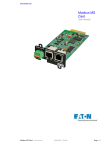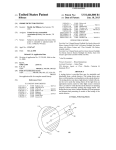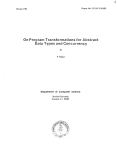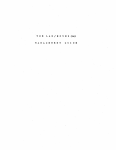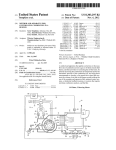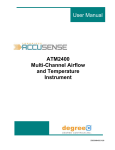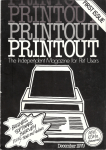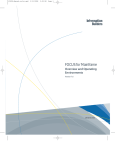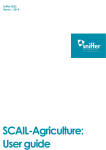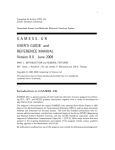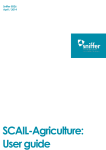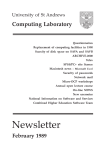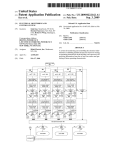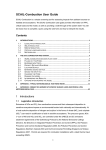Download computing laboratory newsletter
Transcript
University of St Andrews
COMPUTING
LABORATORY
VAX SYSTEMS TIMETABLE
DATA-PREPARATION SERVICE
BREAK IN SERVICE DURING CHRISTMAS VACATION
COMPUTING IN THE HUMANITIES
SEMINARS
SAVING DISC SPACE
USE OF TERMINALS
MANCHESTER REGIONAL COMPUTER CENTRE
NEW VERSION OF GHOST
NEWSLETTER
January
North Haugh, St Andrews
KY16 9SX,
Scotland.
1983
Telephone
76161
VAX 11/780 SYSTE�S TIMETABLE
BREAK IN SERVICE DURING CHRISTMAS VACATION
Candlemas Term 1983
Normally the VAX Systems will be up 24 hours a day,
week, except for the following periods:
7 days a
Systems Development
Week- days:
From 9.45 pm at 24 hours notice.
On occasion a System may have to be
re-booted during the day.
To minimise
any disruption, the re-boots will be
done at about 1 pm.
Weekends:
A System may be taken at any time of
the weekend at 24 hours notice.
Every 5 to 6
weeks:
"Monthly" Systems Disk dumping prior to
PM 7 am - 9.30 am.
Preventive Maintenance (PM) - from about
9.30 am for up to 5 hours (normally 3
hours)
The following PM dates have been scheduled:
Tuesday 8th Feburary
Tuesday 22nd March
Tuesday 5th April
0Eerator Covered Time
7 am to
Access to the building
8 am to 9.45 pm
10.00 pm
Tuesday 10th May
Tuesday 14th June
Honday to Friday
Monday to Friday
Both VAX 11/780 Systems had to be shut down over the Christmas
break because of a fault that was outwith the control of the
Computing L aboratory:
both circuits of the air conditioning plant
failed on Christmas Eve.
The systems were down from 5 pm on Friday
24th to 4.20 pm on Wednesday 29th December 1982 as without cooling
from the air conditioning plant the maximum operational temperature
would have been exceeded in a few hours.
The VAX systems have to be
run within the manufacturer's temperature and humidity specification
or else the conditions of the maintenance contract will be breached
The
and any resulting damage will not be covered by the contract.
Computers have a thermal interlock to trip off the power once the
maximum awbient termperature has been exceeded.
The air conditioning plant was serviced on Thursday 23rd December
by the contractors Walker Engineering.
One compressor was found to be
On
faulty and was switched off by them and a condensor tripped off.
Friday 24th the second compressor went down with a burnt out motor and
as a result the systems were left without any cooling.
The problem
was reported to the Works Department on Friday evening and after
inspection they advised that there was no immediate solution especially
as Walker Engineering was closed until 5th January 1983.
However after much effort from Boxing Day onwards, staff of the
Works Department did manage to get the air conditioning plant going by
improvising and using parts salvaged from the old computer room plant.
That the Computing Service was restored on the Wednesday 29th December
instead of a week later was due mainly to the efforts of the Works
Department staff, to whom the Laboratory must express its thanks o n
behalf o f the users.
VAX Service unattended running
The VAX systems are left running during non-operator covered time
overnight, at weekends and during holidays on the clear understanding
that if the Systems go down for any reason, then no remedial action
will be taken until the next scheduled operator covered period.
Users
planning to make either batch or interactive use of the VAX Systems at
such times do so with this risk in mind.
VAX Maintenance
DATA-PREPARATION SERVICE
Due to heavy demand for the service at certain peak periods (such
as the end of term), for time-critical jobs users should book their
anticipated data preparation requirements well in advance:-- The time
required to do the job will be estimated and a reserved time slot
scheduled for it.
Prior to recording new data for data-preparation users should
consult the Operations Sup�rvisor to ensure that the raw data is
presented legibly and in a format suitable for fast data-entry.
Users with large amounts of data should submit it to the
Operations Supervisor in small batches as it becomes available instead
of one large batch.
This will help smooth out the data-preparation work
load and should enable the task to be completed earlier.
The Computing Laboratory has a DEe service maintenance contract
for the two VAX 11/780 Systems.
This is more expensive than the
Basic contract and covers the systems from 9 am to 5 pm Monday to
Friday except for 10 DEC statutory holidays per year, e.g. 1pm 24th
December 1982 to Tuesday 4th January 1983 (except Friday 3 1st 9am -5 pm)
Under the DEC service contract DEC guarantee to have an engineer on
site within 4 hours of a fault being reported in engineer covered time
(9am - 5 pm).
Air Conditioning Maintenance
The Computer room air conditioning system is maintained by outside
contractors:
The plant by Walker air conditioning and the controls by
Landis and Gyr-Billman Ltd.
There are 5 scheduled preventive maintenance
visits a year.
They respond to reported faults within 24 hours except on
statutory holidays,
e.g. 24th December to 5th January 1983.
January 1983
January 1983
System status enquiries and Terminal Faults
SAVING DISC SPACE
All System status enquiries and terminal faults should be
reported to extension 8131 or 8133.
After 5.45 pm and at weekends
8133 becomes St Andrews 74401.
You
are asked to examine your disk directories and make sure that
you are using the minimum amount of disk space necessary for your work
Please check the time-table displayed on all Terminal Cluster
notice-boards before reporting faults.
on the VAX.
The user disk on SAVA is now more than 9 5% full;
the
situation on SAVB will soon become as critical as this if no action is
taken.
It is in your own interest to conserve disk space to reduce
the chance of wasted effort and time through failed
COMPUTING IN THE HUMANITIES
A seminar will be given on this topic on Thursday 3rd February at
The speaker is
4 pm in Seminar Room 1 of the John Honey Building.
Mr Alastair Pearce, who is the external adviser for Computing in the
Oxford University
Arts at the University of Oxford Computing Service.
o
is a national centre for Arts computing and its specialist facilities are
available to researchers at all U.K. universities.
The
seminar will briefly describe the computer analysis of
literature, with reference to the input of text, its analysis and the
output of the results;
Oxford has facilities to assist in these three
The seminar will also cover the use of statistics and databases
areas.
Mention will be made of applications in Music.
in Arts Computing.
Mr Pearce will be available on Thursday 3rd and Friday 4th
February, during the day, for individual consultations with interested
users.
Contact Peter Adamson (extension 8129) to arrange a time.
Tuesday
18th January
�:
Dr P .
Mars
o
Try to avoid keeping. two copies of a file with minor differences.
Instead use one master copy together with command files contaiL
ing the edits required to generate the variants.
o
Only keep on disk those files which you are currently working
on.
Use the ARCHIVE
command for the long-term storage of
files not in current use.
Archived files are stored on magnetic
tape;
if you retrieve a file from the archive, it is not
necessary to archive it again since the magnetic tape copy is
preserved.
Note that when a file is archived, it is
automatically deleted from your file space and cannot be
retrieved until a month has elapsed.
o
(Leicester Polytechnic)
26th January:
Executing
Thursday
Professor R. Burstall
(Edinburgh)
Alastair Pearce
(Oxford)
Computing in the Humanities
(This is a jOint seminar with the Computing Laboratory)
Thursday
each mail message.
To delete the .MAI file, you will have to
first give yourself permission to do this by the command
SET PROT�O:D MAIL.MAI
Operational Semantics in Prolog
3rd February:
10th February:
B.
Groom
(RAF Leuchars)
o
o
It is hoped to arrange a visit following this talk to see the
simulator.
24th February:
D. R. Brownridge
The Newcastle
Rings from
Connection
UNIX.
Try not to create files containing only a few characters since
the minimum number of blocks that a file can occupy is 3.
Use the command CHOP to remove trailing blanks from files with
fixed record lengths,
using TAPETRANS.
The Phantom Flight Simulator
Thursday
Do not retain files which can be recreated automatically from
other files.
Assuming the normal conventions for file types,
files that must be kept include .FOR, .PAS, .BAS, .S (programs),
.DAT (data), .RNO and .SIM (input to text formatters) and
.COM (command files).
Files to be deleted as soon as they are
no longer required are .OBJ, .OUT, .EXE, .MEM, . DOC , .LIS and
.LOG.
Remember to delete your MAIL;
this is done by using
the DELETE command within the MAIL sub-system after reading
Learning Automata Adaptive Routing Control of
Computer Communications Networks.
Wednesday
Use the PURGE command to get rid of earlier versions of
files.
If you want to hold two or more versions of a file,
use different filenames (rather than version numbers).
Yeu
can set up suitable PURGE commands in your LOGIN.COM file or
(better) use a command procedure at logout time to PURGE unwanted
files (the command BYE will do a complete PURGE of all files il.
your default directory when you logout.)
SEMINARS
The following seminars have been arranged by the Department o f
Computational Science;
th e y will take place a t 4 p m i n Seminar Room
of the John Honey building, except for the first seminar which will start
at 2 pm.
(Newcastle)
- Hiding Communication
jobs and long
edits which cannot be completed due to disk quota problems.
It is
wasteful of resources for the dumping procedures to make backup copies
of files which are no longer required.
The following hints may help
you in reducing your disk usage.
o
such as files read from magnetic tape
Use the command "DlRECTORY/SIZE�ALL".
This will output, for
each file, two numbers.
The first is the number of blocks
occupied by a file and the second is the number of blocks
allocated.
If the number of blocks allocated is 3 or more
greater than that used, reduce the allocation as follows.
Suppose the file TOOBIG.FOR has 11 blocks used and 15 allocated.
First, use the COpy command to create a new copy by typing:
All are welcome to attend.
January
1983
E,
COPY TOOBIG.FOR *
You will find that the new copy will be allocated 12 blocks
(allocations are done in units of ·clusters· where a cluster
contains three blocks).
Second, delete the original version.
USE OF TERMINALS
Long jobs
Jobs that take more than 5 minutes elapsed time to run from a
terminal should be submitted to the appropriate Batch queue instead.
Long jobs run at a terminal prevent other users from making good use
of the terminal.
Reserved Terminals
SAVB terminals TTEO to TTE7 and TTFO to TTF7 are reserved
exclusively for Computer Science students between 9 am and 6pm Monday
to Friday and they have priority on these terminals at other time�.
These terminals and ports are partly financed for the computer Sc�ence
department.
UNIVERSITY OF MANCHESTER REGIONAL COMPUTER CENTRE
Following a period of trial use of the computing facilities at
the University of Manchester Regional Computer Centre the Computing
Laboratory has arranged to buy a very small percentage of the
resources at Manchester thus enabling interested users to use UMRCC on
a regular basis.
The regional service at UMRCC currently consists of two ICL
1900/CDC 7600 systems;
however in April and July of this year a CDC
CYBER 205 system and an Amdah1 470/V7A respectively, are being
installed.
A CYBER 205 is comparable in power to a CRAY computer.
Typical use of the UMRCC system from St Andrews will involve
logging into the ICL 1904S at UMRCC via a SAVA terminal and British
Telecom's PSS system, preparing a job on the 1904S and submitting it to
a 7600 for processing.
Output can be saved on the 1904S filestore
and inspected in a later terminal session.
File transfer facilities
between St Andrews and Manchester are currently undergoing test.
The resource control system at UMRCC is organised so that the
cost of a job is proportional to the CPU time taken on the 7600
multiplied by a priority factor, high priority jobs being proce �sed
more quickly and costing more.
Resources are allocated on a da�ly
Thus
baSiS, with only a limited amount being accumulated if unused.
users who could best make use of these facilities would be ones with a
steady and not excessive requirement (in terms of CPU time) for
facilities that cannot be satisfied locally.
There is a great deal of
applications software at UMRCC (type HELP SOFTWARE EXTERNAL on the
VAX) and a wider range of plotting facilities;
the word length
high precision results to be
(60 bits) in the CDC 7600 enables
obtained in a straightforward manner.
NEW VERSION OF GHOST-3D GRAPHICS SYSTEM
On Tuesday 25th January 1983 a new version of the GHOST-80 graphics
There are several new facilities available
system will be released.
within the new GHOST-80 system and three more 'devices' are now
supported.
Improved versions of the curve-drawing routines CtffiVEO and CURVEC
have been introduced, thereby making their complementary routines
CURVCD and CURVOD redundant.
CURVCD and CURVOD have therefore been
It is now also possible to select a curve
removed from the library.
drawing method that guarantees to produce a single-valued curve from
The new routine CURVEM achieves this.
Two more
single-valued data.
new routines, TYPEST and PLOTST, act exactly like TYPECS and PLOTCS
respectively, but in addition accept control strings, embedded withLl
the character string, which may change text attributes for the
remainder
of the string.
This enables character 'conditions' such
as font change, italics, underlining and magnification to be changed
within a single subroutine call.
The three new 'devices' that are supported are the Benson 9211
electrostatic plotter, the DEC GIGI colour terminal and TRANGRID
seqential gridfiles.
TRANGRID files are essentially sequentially organised GHOST-SO
picture files and as such are suitable for transfer to any other
computer system that runs GHOST-SO.
Thus a very large range of output
devices are now available for the production of pictures created by
GHOST-SO.
The post-processors for the DEC GIGI colour graphics terminal are
used in the same way as those for the Tektronix devices.
A quick
hardcopy of the contents of the monitor's screen (in black and white
only) can be obtained by ensuring that the DECwriter
IV situated
beside the terminal is switched on and by pressing SHIFT/PF1 on the
keyboard.
The libraries are called GIGI and GRIDGIGI.
Pictures
within GHOST-SO gridfiles may be viewed on the terminal by typing
GIGI (cf. T4010 for the Tektronix).
The Benson electrostatic plotter is intended for use when final
The paper is quite expensive and
copies of a picture are required.
The GHOST-SO libraries
should not be used without regard to this fact.
for use with the plotter are called B9211 and GRIDB92l1 and are used
like all other GHOST libraries with the exception that a third library
A typical sequence might
of Benson software must also be LINKed.
therefore be:
$ FORTRAN EXAMPLE
$ LINK EXAMPLE,GHOST/LIB,B9211/LIB,BENSON/LIB
$ RUN EXAHPLE
You will be asked for the name of the (vector) file to which
graphical output for each picture is to be sent.
These files may
subsequently be sent for plotting on the electrostatic plott�r by using
the command PLOT.
Benson vector files may also be created d1rectly
from GHOST gridfiles with the command B9211.
The cost of resources used at UMRCC will normally be met by the
Laboratory as a part of its general service;
however charges may be
incurred through excessive use of PSS.
Users wishing to discuss the
use of UMRCC further should contact Malcolm Bain (ext S203).
January 1983
January 1983
The PLOT command will ask you for the name(s) of the vector files
to be plotted and will create a command file, PLOTJCL.COM, that you
will (generally) submit to the PLOT$BATCH queue for processing.
The Benson plotter may only be used by jobs running in the PLOT$BATCH
queue on SAVB.
Progress of your job through PLOT$BATCH may b e
monitored with the usual SHOW QUEUE command.
On completion, the log
Output
file may be inspected in your top-level directory as usual.
from the plotter will have a banner automatically added to the end of
your plot to identify the owner and will be placed out in the line
printer racks outside the machine room
just as printer output is now.
An updated version of the GHOST-80 User Manual is under preparation,
but in the meantime further information on the new features of GHOST-80
and the characteristics of the new devices and their use with GHOST-80
may be obtained free of charge from the secretaries, or by typing
HELP GHOST NEWS at a VAX terminal.
The old GHOST-80 libraries will be available for a period of 4
To use the old system
weeks after the introduction of the new system.
just type the command OLDGHOST before LINKing the GHOST library.
We
would be grateful however if you could let the Laboratory know of any
particular reason you may have for using this facility.
Please
contact Malcolm Bain
(CLSMB,
ex 8203),
in the first instance.
The pictures shown were produced on the Benson 9211 electrostatic
plotter.
They illustrate the use of the two main methods for drawing
curves in GHOST-SO.
The programs and data for both pictures were the
same apart from the call to the routine CURVEM selecting the different
methods.
ROTATIONALLY-INVARIANT METHOD
METHOD. 1
IN CALL CURVEM (METHOD)
MONOTONIC METHOD
�ETHOD"2
If< CALe. CURVEM
DraWing Curves with GHOST-3D
January 1983
{METHODl





